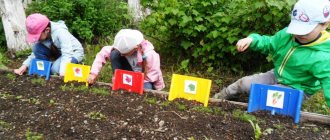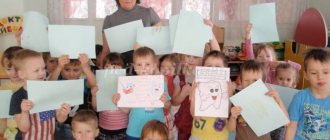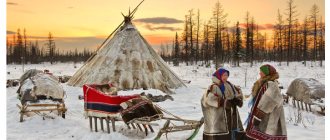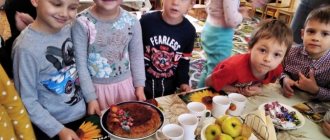Research project “Anthill Life”
Purpose of the work : protect anthills from destruction.
Project characteristics:
by dominant activity - social research, with elements of creative activity of students; in the subject area – natural science using interdisciplinary integration (music, visual arts); by the nature of contacts between project participants - intergroup; by duration – long-term (one month); type of presentation - role-playing game: product - an action to protect anthills, with the creation of a sign informing about the location of anthills, information posters about the benefits of ants and the need to treat them with care.
Social research tasks:
- Find out as much as possible about the life of ants (conduct observations, experiments).
- Involve all preschool children in the secrets of the life of ants.
- Organize and carry out an action to protect anthills.
Research methods and tools:
- Observation.
- Experiment.
- Analysis.
- Generalization.
Tools used:
1. Methodological, artistic, educational literature.
2. Visual aids for offices. Equipment: film about the forest, appropriate design of the ecological trail, anthill, ants, route sheets, cards - sources of information; cards for organizing collaboration in groups; materials for constructing ants, anthills, relevant fiction and scientific literature; illustrations, musical accompaniment, signal cards, creative newspapers for pupils of senior groups.
Preliminary work (work in the “Ecological Trail” system of activities): conversations, games, looking at illustrations, dummies, learning poems about nature, excursions, making crafts.
Those present: pupils of the preparatory group, teachers of preschool educational institutions, parents of pupils.
Progress of the lesson
35 minutes
Organizing time.
Classes take place in an ecological zone. There is a spring forest on the screen. Children set off on another journey along an ecological trail using route sheets (a sheet of a certain color, the commander is an “asterisk”. Stop “Anthill”).
Introductory part.
Leading. Hello guys, adults, guests. Today we continue our journey along the ecological trail. We learned a lot of interesting things about autumn and winter natural phenomena. We admired the beauty of nature, learned to protect and enhance it. And finally spring has come to Yamal! What changes in nature have you noticed (listing)?
Ant. (An ant jumps out onto the path crying.) Trouble! Trouble! Help! Save!
Leading. Who is this? What's happened? Let's see?
Children. (They approach the anthill. They examine it). The anthill is ruined. Ants are in trouble. They are fussing. They run around their home.
Leading. How could this happen? Who did it? (Strictly, addresses the children).
Children. (Confused). This is not us. Possible answers: We don't know how it happened. This is a bear. Who else could have done this?
Main part.
Leading. Do you feel sorry for the ants? Want to know how to help them? How to save them?
Leading. To do this, we need to learn as much as possible about ants. How to do it? Let's draw up a work plan.
Work plan (proposed by children):
- Get acquainted with available research sources:
- Think for yourself.
- Get acquainted with books together with the teacher and parents about what you are researching (library).
- Ask other people (medical office, children's creative laboratory, music room, art studio).
- Get acquainted with films and television films on the topic of your research.
- Observe (excursion).
- To conduct an experiment.
Contents of project activities
Leading. Think for yourself. What questions would we like answered? What do we want to know?
Theoretical part.
- Where do you live?
- How do ants build their anthill?
- What do ants look like?
- How does life work in a large ant commune?
- Who are your friends and who are your enemies? Interesting stories from the life of ants.
- What benefits do ants bring?
- Ants, we will save you.
Leading. Now let’s divide into groups and continue practical work (determine topics based on interests, divide children using colored cards - signals). Children go with their leaders to receive information on their interests and get to work (to the kindergarten library, medical office, music room, children's creative laboratory, fine arts studio).
Practical part 1. Defense of a social research project.
In the form of a role-playing game, the result of the research project “Anthill Life ” is presented: an action is organized to protect the “Anthill”,
- Speech by mini-group leaders (Appendix 1).
- Mini-group report on the work done (a story about how the idea of protecting ants arose, what difficulties there were in working on the project, what ideas were rejected, which ones were accepted and why, how difficulties were overcome (using photo and video materials).
- Asking questions by listeners. Responses from project participants.
- Organizing an action to protect an anthill from destruction by people (analysis of all the ways to protect an anthill proposed by children, improving a sign to protect anthills, creating posters and leaflets on protecting anthills).
Sample conversation:
Host: You really learned a lot about the life of ants. Do you think there is anything we people can learn from them? How can we help them?
Sample answers from children:
Don't destroy anthills. Be quiet in the forest. Tell other children about the benefits that ants bring.
Offers:
- Create a sign “Attention, Anthill”, which warns about the presence of anthills in a given place and prohibits approaching close to them.
- Draping red ribbons around trees as a sign that there are anthills here means you need to be careful and attentive.
- Develop informational posters “Ants are strongmen!”, calling for people to be more attentive in the forest, remember the forest is the home of animals and plants, and you need to behave in it like a human being.
The result of the social research project for preschoolers is assessed by an expert group consisting of the deputy head for scientific and experimental work, the Minister of Children's Press, and a representative of the parent committee of the preschool educational institution).
Conclusion(s):
We believe that we learned a lot of interesting things about the life of ants, and were able to convince the children of the preschool educational institution that it is impossible to destroy anthills, and in general treat animals cruelly. We hope that making warning signs to protect anthills will once again make the children think about how important it is to be friends with nature, to be kinder and closer to it. During the research, we acquired important skills that will help us independently acquire new knowledge. But this is so interesting! We are confident that we have completed the main task of our work - none of the children living in our village, much less adults, will destroy an anthill, will not offend the little worker of nature, the strongest and at the same time completely defenseless animal in the world. light - an ant. And one more thing - during our work we learned a lot from the ants and became very friendly. We will continue our work on monitoring anthills, and perhaps we will be able to learn something previously unknown and unexplored.
Research paper “Are ants intelligent?”
Ants are amazing creatures! Tiny insects, but so strong, hardworking and persistent! Ants live close to us, but have we studied them well enough? Do we know everything about them? I became interested in ants when I discovered an anthill near my grandmother's house. I began to observe the life of ants, feed them, and conduct various experiments. And this is what I discovered. It turned out that the anthill is an entire city, or even a state. In it, every resident is busy with his own business. Real roads lead to the anthill, and inside it there are various passages - communications. An anthill lives as a single organism. When an ant finds food, it does not eat it alone, but tries to deliver it to the anthill. If one ant cannot do this, his comrades help him. Ants always work together. Try to disturb an anthill - the ants immediately rush to its defense! At the same time, their main concern is to quickly transfer and hide their offspring. I thought: if ants know how to build roads and cities, if they are always busy with a common task and communicate with each other, maybe they are intelligent? And so I decided to look into this issue.
The life of the ant community became the object of my research.
The relevance of the study lies in the fact that currently people, with the help of machines, are increasingly destroying the ecology of our planet, not paying attention to the unique systems and communities that exist next to them, not noticing such small neighbors as ants. It is necessary to draw attention to further study of the species living on Earth and increase human responsibility for their conservation.
hypothesis : ants have the qualities of intelligent beings.
The goal of the project: to establish signs of intelligent behavior in ants.
Tasks:
- study specialized literature on the chosen topic;
- carry out constant monitoring of the research object;
- conduct experiments aimed at identifying the behavioral characteristics of ants;
- collect additional information from available sources: television, Internet, direct communication.
While working on the project, I learned a lot of interesting and amazing things about ants.
As a result of my research, I came to the following conclusions:
- Ants are insects that live in complexly organized communities that obey their own laws.
- Ants have good memory, the ability to learn, and can transmit information to each other.
- Ants are intelligent! But this is not the mind of each individual creature, but the collective mind of the ant community.
- It is the collective mind that helps ants survive, adapt to any conditions, and preserve their civilization. And this intelligent civilization does not exist somewhere in outer space, but on the same planet as us!





